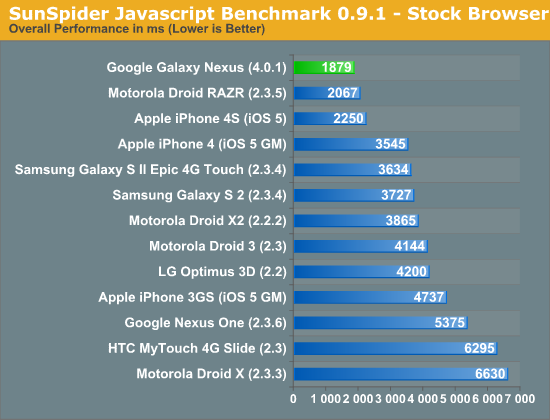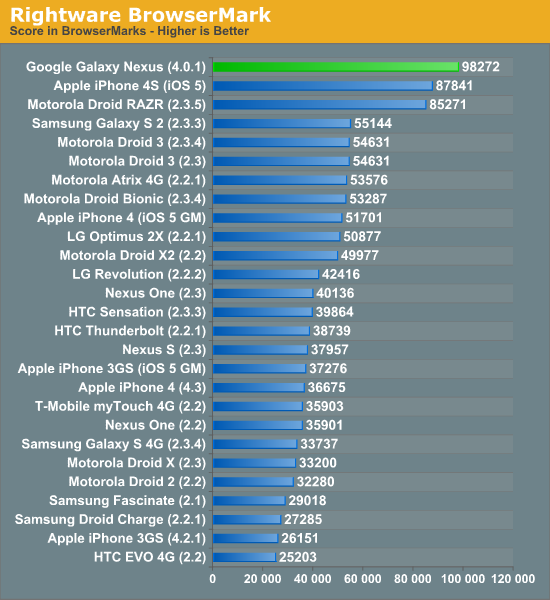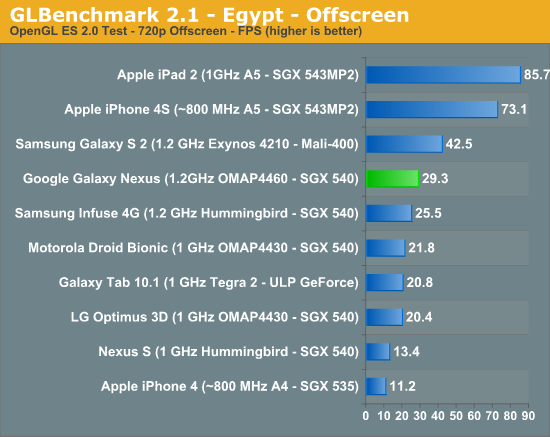Galaxy Nexus & Ice Cream Sandwich: Initial Performance Analysis
by Anand Lal Shimpi on November 18, 2011 11:42 PM ESTThe road to Google's Galaxy Nexus and Android 4.0 (Ice Cream Sandwich) is finally nearing its destination. As of yesterday, the Samsung made Galaxy Nexus went on sale in the UK. Its arrival in the US on Verizon is imminent, but it'll still be another couple of weeks before we can get our hands on a CDMA/LTE sample.
The Galaxy Nexus hardware platform isn't a significant departure from what we've already seen on Android. TI was chosen as the launch silicon partner with its OMAP 4460. The SoC takes a pair of Cortex A9 CPUs running at 1.2GHz and gives them a dual-channel LPDDR2 memory interface to talk to. The GPU is Imagination Technologies' PowerVR SGX 540. The CPU side of things is comparable to Apple's A5, although the cores are clocked noticeably higher than the 800MHz we saw in the iPhone 4S. Until Tegra 3 and Krait show up, the CPU side of the 4460 is as good as it gets.
The real advantage the Galaxy Nexus has is on the software side. All of the goodness of Honeycomb makes its way to a handset along with even further optimization work. One of the early Galaxy Nexus owners ran the usual browser benchmarks on his phone and shared the results with us. Google has obviously done a lot of browser optimization in ICS as performance is now better than even Honeycomb:


The GPU in the Galaxy Nexus isn't bad by any means - the SGX 540 is competent, but it is outgunned by ARM's Mali 400 (Samsung Exynos 4210) and the SGX 543MP2 (Apple A5). As I mentioned earlier, the Galaxy Nexus wasn't about putting the fastest hardware in a phone but rather providing a stable vehicle for Ice Cream Sandwich. Results for the Galaxy Nexus have been in the GLBenchmark database for a while and show an overall improvement over previous SGX 540 implementations (the GPU clock in the 4460 is higher than in the 4430):


Performance is pretty much as expected in both areas: Google really pushed the performance of its software further with Ice Cream Sandwich, while GPU performance is limited by the SGX 540. The good news is that there's more than enough hardware at ICS' disposal to deliver a smooth experience. We'll be able to quantify that once we get our hands on a device.
Source: GLBenchmark, @SigThief










69 Comments
View All Comments
Electrofreak - Sunday, November 20, 2011 - link
I disagree completely, stm1185. The SGX 540 in the Galaxy Nexus is a GPU that has long been hobbled by the slow memory it's been paired with on a single-channel memory controller, as well as feature size limitations that prevented it being clocked as high as it could be.The SGX 543MP2 in the iPhone 4S is basically a tweaked, dual-core version of the SGX 540, and isn't anything revolutionary, it just eats up more power, costs more money, and requires more die space.
The Mali-400 MP4 in the SGS2 is performing better than the SGX 540 in benchmarks because of fill rate. Read this article by Anand, it explains some of the differences between the GPUs: http://www.anandtech.com/show/4686/samsung-galaxy-...
When it comes to handling polygon counts though, the SGX 540 is actually much more capable. Next year's games will be very poly-intensive and this is where the SGX 540 can actually start outperforming the Mali-400 in the SGS2.
Regardless, it's basically a moot point. The 304 MHz SGX 540 in the Galaxy Nexus still performs better overall than Qualcomm's Adreno 220 and the NVIDIA GeForce ULP currently in Tegra 2 phones. There are still high-end phones launching with those GPUs and if we should be worrying about any phones struggling with games next year, we should be worrying about those.
vision33r - Sunday, November 20, 2011 - link
Nvidia is such a big disappointment. They should be the leader of dedicated graphics.Let's see if the Tegra 3 gets a bigger improvement, I don't think it will be that big of a jump since Nvidia tends to rush things out the door than getting it right.
thunng8 - Saturday, November 19, 2011 - link
Huh yourself ..All the phones were tested at the same resolution to gauge the performance of the GPU.
xype - Saturday, November 19, 2011 - link
Which means that the GPU performance in 3D games will be awesome! \o/On a more serious note—are those 920k pixels on a pentile display also rendered as such or are they effectively less? Or, alternatively, would rendering a smaller resolution and upscaling it be that much worse on such a display?
melgross - Saturday, November 19, 2011 - link
Effectively less, as they have been for all PenTile displays.eallan - Saturday, November 19, 2011 - link
For all intents and purpose they are treated the same. Regardless of each pixel being 2 subpixels instead of 3, it's still a "pixel."ZoZo - Saturday, November 19, 2011 - link
Indeed, they are all tested at 720p offscreen, it's mentioned under the title of the benchmark. So the GPU of the iPhone 4S is more than twice as fast, which isn't surprising considering that it's an evolution of the one in the Nexus, with twice the processing units.jalexoid - Saturday, November 19, 2011 - link
It's 2x as fast in raw performance, but in more down to earth scenarios (Egypt) it's not that far ahead. I blame the memory interface in A5 for the lower scores.thunng8 - Sunday, November 20, 2011 - link
Not quite sure what you are talking about.In Egypt the iphone4S is 2.5x faster than the Nexus Galaxy and in Pro it is 2.7x faster. In both benchmarks to is significantly faster than 2X.
jacknhut - Saturday, November 19, 2011 - link
Would like to see how HTC Rezound perform against this Nexus S since it is after all the biggest rival to the Nexus S at the moment.